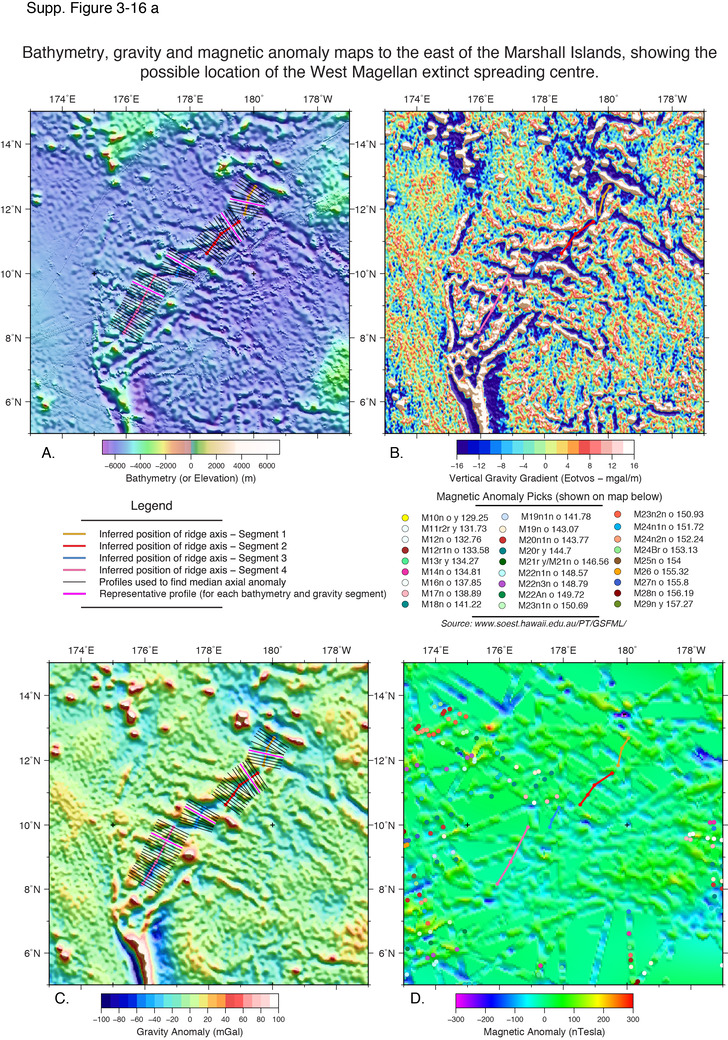| Ocean: | Pacific |
| Spreading center type: | Microplate spreading ridge |
| Time of cessation: | 136 Ma, Chron M14-M15 (Nakanishi and Winterer, 1998) |
Nakanishi and Winterer (1998) reviewed magnetic profiles across the extinct ridge segments, in combination with the contemporaneously published satellite gravity of Sandwell and Smith (1997) and made a strong case for the spreading-centre origin of this feature. Nakanishi and Winterer (1998) proposed that the spreading centre was active between Chron M20 and M14 and constituted a microplate spreading ridge on the 'Trinidad' microplate. Nakanishi and Winterer (1998) suggest that formation of the plate was a result of a major plate reorganization at the triple junction boundary of Pacific-Farallon-Phoenix plates, but pre-dated the Magellan Microplate spreading system.
The extinct ridge is to the west of the Magellan extinct ridge centre, and is a segmented linear negative gravity feature that is cut by several orthogonal fracture zones. The extinct ridge is similar in appearance to the extinct spreading centre in the West Philippine Basin. To the west, the area is bounded by the curved Victoria fracture zone (Nakanishi and Winterer 1998), and broad, low-magnitude gravity highs, which contrast to the significant low-gravity anomalies seen within the suspected ridge axis and transform faults. The western curved feature is strongly suggestive of a pseudofault, perhaps associated with rotation of this proposed microplate. The northern flank of extinct spreading-centre has good coverage of magnetic anomaly identifications, which are younger toward the ridge-like structure.
Nakanishi and Winterer (1998) argue that the Magellan and Trinidad microplates were present during a transitional phase of the PAC-FAR-PHO plate configuration from fault-fault-ridge,that may have prevented a stable plate configuration when influenced by small changes in plate boundary geometries. They also argue that it was an early stage in the eastward propagation of the Pacific-Phoenix ridge, that they believe continued until the plate boundary ceased at M0 (Nakanishi and Winterer 1998), that has been shown by others to have ceased at the Nova-Cantos Trough. The Trinidade microplate was believed to represent spread with the Pacific plate, and sandwiched between the Pacific-Phoenix plates, yet no evidence is available to suggest the paleo-boundary with the Phoenix plate (Nakanishi and Winterer 1998). Alternatively Nakanishi and Winterer argue that a hotspot that may have formed the Magellan Rise (believed to have been formed at M22), could also have contributed to formation of the microplate. Morphologically, the microplate is found to be shallower on the northwestern flank (Nakanishi and Winterer, 1998) that border the nearby plateaus that have mild positive gravity anomalies. Nakanishi and Winterer (1998) argue that the microplate did not experience rotation, yet the curved Victoria fracture zone and the very different trend of abyssal hills either side of the extinct ridge axis hint that the pole of rotation was close-by and that rotation of the entire spread centre may have occurred.
Nakanishi and Winterer (1998) argue that the Magellan microplate started spreading at Chron M15, prior to cessation of the Trinidad Microplate spreading centre and that the northward propagation of the former, effectively starved the latter, preventing it from continued spreading. The orientation of the Magellan spreading centre and trend of anomalies formed at the centre are distinctly different from the Trinidad centre and therefore the plate boundary geometry had changed significantly by the time of establishment of this centre.
The West Magellan extinct spreading ridge is considered a well-defined extinct ridge that is a type-example of an extinct microplate spreading ridge.
Nakanishi, M. and Winterer, E.L., 1998, Tectonic history of the Pacific-Farallon-Phoenix triple junction from Late Jurassic to Early Cretaceous: An abandoned Mesozoic spreading system in the Central Pacific Basin, Journal of Geophysical Research, v. 103, p. 12453.
Sandwell, D.T. and Smith, W.H.F., 1997, Marine gravity anomaly from Geosat and ERS 1 satellite altimetry, Journal of Geophysical Research, v. 102, no. B5, p. 10039–10054.
Tamaki, K., Joshima, M. and Larson, R.L., 1979, Remanent Early Cretaceous spreading center in the central Pacific basin. Journal of Geophysical Research, v. 84, no. B9, p. 4501–4510.


